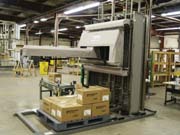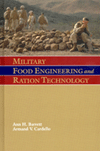
But more is often less when machinery is over-designed, and engineers do well to recall the advice to "Keep It Simple." A recent example is the K-Bot palletizer, an end-of-line, cable-powered, four-axis machine with a small footprint and a lot of muscle and versatility in building multiple pallet configurations. An alternative to sophisticated robotic palletizing units, K-Bot actually has several advantages over higher priced alternatives.
K-Bot was designed and built at Schneider Packaging Equipment Company Inc., a Brewerton, N.Y., machine shop founded in 1970. The company has been involved in the OMAC (Open Modular Architecture Controls) Users Group since its inception. Richard S. Schneider is the second-generation president of Schneider, which was founded by his father, a mechanical engineer. Richard Schneider began assembling equipment at the firm in 1972, while still in high school. College coursework in kinetics and mechanical engineering rounded out a mechanical aptitude born of three generations of tool builders, and high school level drafting courses helped him segue to computerized design with the advent of auto CAD. After building a machine, company workers were expected to install their project in the field, giving them a real-world view of what worked and what didn't. Schneider also had the good sense to surround himself with experts such as Dave Schlueter, chief engineer on the K-Bot project, and Pete Squires, vice president of controls.
About a dozen Schneider employees were involved in the design and fabrication of K-Bot. Food Engineering recently spoke with Richard Schneider about the project and the rationale for combining cable power with modern controls.
FE: Before K-Bot, what was Schneider's experience in automatic palletizing equipment?
Schneider: In the early 1980s, we built five conventional palletizers before we were introduced to an Italian robotics company. They eventually stopped making robots and started providing us with out-of-the-box, conventional robots from companies like Fanuc and Motoman.
Robots work great, but the drawbacks are the control package and the height limitations on the pallets you can build. We used an Allen Bradley solution involving a PLC and servos early on, and that system had to be tuned on the fly and had limitations. The units came with electric, pneumatic and mechanical drives, servos for the up and down axis, and air cylinders or motor reducers for the back and forth axis.
FE: What was the inspiration for cable power?
Schneider: Our idea was to take all the motors, reducers, gripping equipment and other components off the arms of the unit, since those reduce the lifting payload of a robot significantly. The first attempt involved a pick-and-place design with a belt drive. It worked well in two axes, but when we got deeper into the design, it became hard to turn the belts, and we ran into a lot of restraints in turning and looping.
Next we tried a system of pulleys and cables, much like the systems you see on large cranes used in bridge building. K-Bot has four servo-operated motors, but they are stationary, with a set of cables for each axis. The cables are the power transmission method. In a typical palletizer, motors are mounted on the part that is moving, and long cables are twisted constantly. That creates a lot of maintenance issues that are now avoided with this design.
FE: How does this improve on robotic units?
Schneider: We're not limited on the height of the pallet being built. We could palletize up to 10 feet, which is the upper limit that a truck pallet could be built. Robots can do double heights, but they require a lot of room to do it, and there's usually not enough real estate at the end of a line in a food plant. That's partly why many plants palletize in a remote warehouse, which means more capital and maintenance costs for conveyors to get cases to the warehouse. This unit has a large work envelope in an extremely small footprint, 62 by 104 inches, and the cost is about $15,000 to $20,000 less than a robotic palletizer. An end-of-line approach to palletizing is a plus when product validation and traceability is a big issue, as it is in pharmaceuticals and is becoming more so in food processing.

Schneider: A lot of individuals understand the operating principles of cables and can troubleshoot and attend to the system, and you don't need to understand what is inside the control package to run the machine. You can make a system as complex as you want, but then you end up with something where IT people or other highly trained technicians have to be called in when something goes wrong. This was designed so that an average operator can add new pallet configurations, handle different products, and deal with the day-to-day issues of operation without weeks of specialized training.
Rockwell ControlLogix with Kinetics 6000 was used on the controls. It's an absolutely gorgeous control panel, with very simple wiring. The HMI is a Panel View Plus touch screen, which uses a straightforward, common sense approach to walk operators through. Some pretty amazing calculations are going on inside the controller, but the operator doesn't need to know that.
FE: What kind of calculations?
Schneider: The kinetic control package runs through a number of options until it determines the optimum path to be taken. It's not a one up, two over, one down pattern. As the pallet is built, the optimum path changes, since there may now be a case blocking the most direct path for the case being placed.
PackML (OMAC's packaging machinery language) was used to name machine states and help make this an open communications system. The goal is to have everyone understand what is going on in the unit without specialized training and make it easy to integrate with other machines through the onboard Ethernet connection. Pete Squires was on the OMAC packaging group's executive committee in its first two years, and we remain active in the group and committed to open architecture.
FE: What aspects of design and construction were most challenging?
Schneider: Dave had to come up with something that was light but strong and that could also keep tension on the cables despite the many movements involved. The mechanical side of the unit is unique, and we didn't have much experience in designing anything like it. Many CAD designs were required to come up with a system that avoided cable collisions.
The software platform is something we've worked with for a number of years, and we had more resources to draw on for that aspect. Rockwell Automation was a great help, as was Hoffman with the electrical panels and alpha gear drives Inc. for the reducers.
FE: How reliable is the system?
Schneider: It's still too early to offer any empirical data. We're in the process of trying to break it ourselves in order to do the failure analysis. But we're applying a lot of our past experience on the controls side and expect it to be highly reliable. On the mechanical side, once the cable was strung, it worked.
FE: Do you see this as an entry-level machine for companies automating pallet building for the first time?
Schneider: The potential user group is broad. We build complex, centralized robotic systems also, and sometimes that is the best way to go. But there are a lot of applications where that isn't a viable option.
Some people like this because their mechanics can work on it without calling in outside experts. The work output is a plus: it can do things that other systems just can't. And the cabinets, motors and bearings are sealed, with no hidden cavities in the design. Stainless steel housing is an option, which would help meet the hygiene requirements for operating within a food plant. This is really a different machine that's meant to fill an unfilled need.

